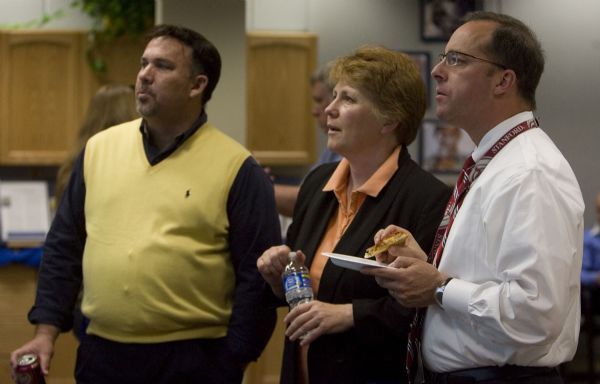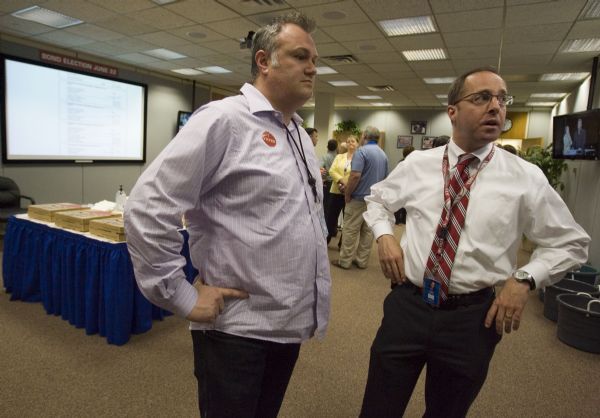This is an archived article that was published on sltrib.com in 2010, and information in the article may be outdated. It is provided only for personal research purposes and may not be reprinted.
Utah's youngest school district will observe its first birthday on Thursday. But one year after Canyons was born through a bitter split with Jordan School District, it's unclear whether students -- or taxpayers -- on either side are better off. ¶ The divorce broke up Utah's largest school district -- 81,000 students in the south Salt Lake Valley -- and created the first new school district in 100 years. The process, an east-side vote that excluded west-side Jordan residents and left them with less money per pupil, sparked resentment on both sides that still festers. ¶ The breakup alone cost taxpayers $33 million, according to a Salt Lake Tribune analysis done in 2009. The tab included $3 million in legal fees paid by both sides, the cost of hiring people to run Canyons and the expense of relocating Jordan's central offices.
So far, class sizes are no smaller, taxes are higher and there is less help for kids struggling to read in both districts. Both are dipping into construction funds to cover operating expenses, a fix offered by the Legislature that is available for only two years.
While Canyons Superintendent David Doty plans to raise the academic bar next year with advanced diplomas, the district will also shorten the school year by five days for 2010-11. In Jordan, schools will experience turnover as 190 people are laid off, bumping other employees with less seniority.
And next school year, combined spending in Jordan and Canyons is budgeted to exceed general fund expenses in the old Jordan district by $17.5 million.
The recession is no doubt a factor in the financial troubles both districts are experiencing. But no one is asking whether they could have weathered it better together.
A survey of Canyons parents completed in February found 81 percent approved of the district's operations in the first seven months. And Jordan Superintendent Barry Newbold said he's "optimistic about the future."
--
A tale of two districts » Parents, teachers and administrators in Jordan and Canyons say students have seen little impact from the split.
"They noticed new logos on the school buses," said Doty. "Hopefully, they didn't notice much else. ... Our first priority was to do everything we could to ensure minimal disruption of services."
Diana Bennett, a Sandy mother of four in Canyons, said the smaller district is more responsive. She is pleased the district's $250 million bond will be spent sprucing up decrepit schools.
"It's just night and day -- so much better," she said.
Her son, a new graduate of Hillcrest High, liked the district's new, healthful lunch menu -- no fried foods, more vegetables and wheat bread only. (But his third-grade sister thought the mashed cauliflower was the most "awful" mashed potatoes she's ever tasted.)
In Jordan, Bennett said, she would be told "over and over" when she had a concern: "We're just such a big district we can't focus on that."
She would wonder, she said, "Then why are we such a big district?"
Jordan lost 41 percent of its student population but 58 percent of its property-tax base when Canyons broke away. It amounted to an annual loss of $18.7 million in property taxes, but the hit shrank to $8 million after the Utah Legislature agreed in 2008 to require all districts in Salt Lake County to share some revenue with Jordan.
In next year's budget, Jordan had to plug a $29 million shortfall, while Canyons filled a $13 million hole. Both approved tax-rate increases for 2009-10 -- 20 percent for Jordan and 17 percent for Canyons. But because of changes in assessed values, for every $100,000 in home value, Canyons' boost results in an average 71-cent increase per year while Jordan's hike tacks on $68.
Canyons is shortening the school year by five days to save $3.5 million. Jordan is cutting jobs and programs to save $17.2 million.
Both districts, in a change bound to lessen one-on-one attention for struggling elementary students, are reducing by half the number of reading specialists, leaving one for every two elementary schools instead of one per school. In Canyons, the literacy experts are being replaced by academic coaches, who also will work on math skills.
Jennifer Boehme, a sixth-grade teacher at Elk Meadows Elementary, worries about the loss of support staff throughout Jordan district.
"All of those people play a role in keeping schools safe and giving extra help to those students who need an extra boost," said Boehme, who recently stepped up as Jordan Education Association president. "The classroom teacher has to manage more. It becomes very difficult to maintain the quality level we've had in this district for so many years."
Jordan officials hope the worst of the split's fallout is behind them. "We are now poised to put the financial challenges behind us and move forward, enabling us to focus our energy on students and their success," Newbold, tehe Jordan superintendent, said via e-mail.
--
A battle over buildings » Spending on school buildings was a source of conflict before the breakup and is cited by some as a prime cause of the split. In 2003, Jordan district voters, including those on the east side, overwhelmingly approved a $281 million bond that built or renovated 19 schools, all but one of them on the rapidly growing west side.
Other proposals to handle the west-side growth included busing students to neighborhoods with declining enrollment and closing less crowded east-side schools.
"It became very apparent there was a disparity between the needs of the two sides of the district," said Cottonwood Heights Mayor Kelvyn Cullimore, a leading proponent of the split. "We didn't want to have communities with closed and run-down schools. Our concerns were falling on deaf ears."
From 1992 to 2007, Jordan spent the bulk of its capital funds, aside from the bond, on east-side buildings. During that time, $169 million flowed to east-side schools and $52 million went to the west side, said Jordan spokesman Steve Dunham.
"It's not like east-side schools were neglected," Dunham said. "No schools were unsafe. ... When you have tremendous growth on one side and declining enrollment on the other, where are you going to build schools?"
Canyons residents are still paying their portion of the 2003 Jordan bond, which is 58 percent based on the east-side's share of property values at the time of the split. As the bond payments decrease each year, Canyons plans to keep residents' property tax bills the same, capturing the difference to pay off the new $250 million bond that voters narrowly approved on Tuesday. Without the new bond, they would have gotten a tax break.
Unofficial returns show the bond passed with only 50.7 percent of the vote.
The money will be used to build a high school in Draper and rebuild or renovate a dozen aging schools. In placing the bond on the ballot, board members said they were following through on one promise of the new district: upgrading earthquake-prone and non-air-conditioned schools on the east side.
But that's not the end of the construction wish-list: Canyons officials say there's another $400 million in needed improvements. There's no firm plan for funding those projects, although additional bond issues are a possibility.
While Canyons is still on the hook for 58 percent of Jordan's bond debt, new numbers of the Utah Tax Commission show that assessed valuation between the two districts is now even.
Each has $16 billion worth of taxable property, said Tax Commission spokesman Charlie Roberts. That reflects a yearly jump of 15 percent for Jordan and a drop of 5 percent for Canyons.
Part of the change, Roberts said, is because last year, the commission incorrectly assigned $700 million of Kennecott Utah Copper property to Canyons district instead of Jordan. Canyons did not receive that property-tax revenue, but the assessed valuation numbers for both districts were inaccurate.
In Jordan, $2.6 billion of the $2.75 billion boost is an increase in the value of "centrally assessed" properties, which include utilities, mines and railroads. Real estate shot up $97 million because of new development, according to Roberts.
"The Jordan School District has plenty of tax base to operate independently and efficiently," said Doty, the Canyons superintendent. "It's just a straight-out myth that this district is flush with cash and everyone else is rolling in poverty. ... It's time for people to move forward and stop looking backward at perceived negative consequences of this [split] process."
Even if assessed value has increased in Jordan, the district will collect the same amount of revenue it did last year, said Newbold. That's because, by state law, taxing entities receive the same distribution each year unless they go through the "truth-in-taxation" process to capture additional tax revenue.
--
Looking forward » The turmoil caused by Utah's first school district split has prompted many people, including state lawmakers, to look for more equitable ways of sharing school funds throughout the state.
Many say the law that allows districts to divide also should be changed to allow all residents of a district to vote.
This year, the Legislature amended the district-division law to give districts additional time to transition. But an attempt to require districts that divide in the future to split property-tax revenue evenly failed.
Some lawmakers are looking to "equalize" school funds as a way to ensure fairness for all students. The state divvies out per pupil funding evenly, but total funds vary by district because of local property-tax revenues.
"I don't believe a ZIP code should determine what kind of education a child should have," said Rep. Jim Bird, R-West Jordan, an opponent of the Jordan split. "Statewide equalization needs to happen. It's the right thing to do for the state of Utah."
Sen. Howard Stephenson, R-Draper, plans to push a plan for "backpack funding," which would distribute all educational monies on a school-by-school basis.
He supported breaking up Jordan, but believes more, even smaller districts, should have been created. Jordan and Canyons remain the fourth- and fifth-largest districts in the state, respectively.
Legislation to create new districts, he said, "was sold on the idea that smaller districts are more responsive and closer to home," not to cut large districts in half.
"Instead of a giga district, we now have mega districts," he said.
South Jordan mother Zakia Richardson hopes the split turns out to be a "blessing in disguise" for Jordan district, which she worries is top-heavy with administrators and doesn't always spend its money wisely. She says parents are now more aware and involved in district decisions, encouraging greater transparency and efficiency at Jordan.
"We moved here [three years ago], and I was under the impression that Jordan School District was one of the best in the state," Richardson said. "I'd like to see everyone cooperating -- parents, teachers, administrators -- to make Jordan district the jewel of Utah once again."
March 2003 » Utah Legislature passes law that allows the creation of new school districts. Amendments are made in 2006 and 2007 to allow cities, representing 80 percent of constituents, to place a proposed district on the ballot.
May 2007 » Coalition of east-side Salt Lake Valley mayors in Jordan School District release study on feasibility of new district.
August 2007 » Cottonwood Heights, Draper, Midvale, Sandy and Alta band together and seek a new school district on the November ballot. The proposed district covers the east side of Jordan School District, including unincorporated pockets. It excludes a portion of Draper in Alpine School District.
September 2007 » Herriman files federal lawsuit aimed at thwarting split, arguing the ballot measure is unconstitutional because it disenfranchises the district's west-side voters. The lawsuit ultimately fails, with litigation ending in 2010.
September 2007 » Jordan sells remaining $196 million of the $281 million school bond approved by voters in 2003. The money primarily funds construction of new schools in the district's burgeoning west side.
October 2007 » Jordan board passes resolution in support of an undivided district.
November 2007 » Voters in what would become Canyons School District agree, by a 6 percent margin, to break away from Jordan.
June 2008 » Both districts hold elections to select new board members.
October 2008 » The new district picks "Canyons" as its name after holding an online contest.
March 2009 » After transition teams for each side fail to agree, an arbitration panel divides Jordan's assets. Each school district gets the property within its boundaries. Cash is divided on a per-student basis, leaving Jordan with 59 percent and Canyons with 41 percent.
July 2009 » Jordan and Canyons begin operating as separate districts.
Source: Salt Lake Tribune archives
Jordan School District before split
Students » 81,017.
Average class size » 22 for grades K-3; 26 for grades 4-8; 27 for grades 9-12.
Property-tax revenue in the general fund, per student » $1,250.
Spending per student » $5,789.
Jordan, after split (2009-10)
Students » 48,439.
Average class size » 22 for grades K-3; 26 for grades 4-8; 27 for grades 9-12.
Tax-rate hike » 20 percent.
Property-tax revenue, in the general fund, per student » $1,064.
Spending per student » $5,876.
Canyons district, after split (2009-10)
Students » 33,184.
Average class size » 22 for grades K-3; 26 for grades 4-8; 27 for grades 9-12.
Tax-rate hike » 17 percent.
Property-tax revenue in the general fund, per student » $1,660.
Spending per student » $5,974.
Source: Jordan and Canyons districts









